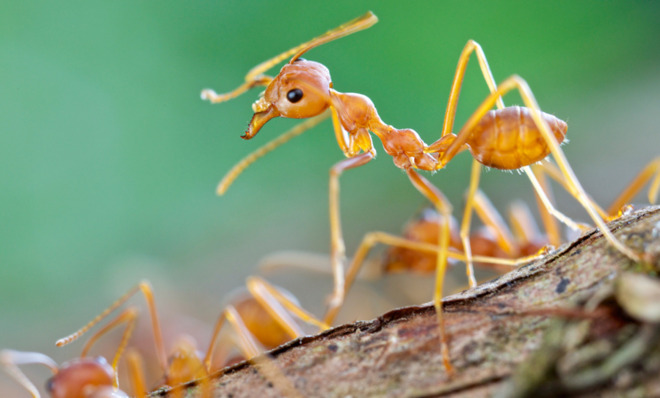The useful versatility of the humble ant
Ants can be used by other animals for a variety of purposes, including as camouflage and home security systems

For humans, ants are usually not much more than an annoyance, creeping into our kitchens or disturbing our picnics. But many ant species aren't to be trifled with. They're territorial. They're aggressive. They stick together in large groups. They have strong jaws and can deliver painful bites; take the bullet ant, whose bite is comparable to "walking over flaming charcoal with a three-inch nail embedded in your heel."
Many animals wisely avoid them, but others use ants to their own advantage. They exploit their ferocious traits and use them as disguises, protectors, mercenaries, and, as scientists have recently discovered, home security systems. Here are just a few ways other animals use ants for their own purposes.
A coat of corpses
The Week
Escape your echo chamber. Get the facts behind the news, plus analysis from multiple perspectives.

Sign up for The Week's Free Newsletters
From our morning news briefing to a weekly Good News Newsletter, get the best of The Week delivered directly to your inbox.
From our morning news briefing to a weekly Good News Newsletter, get the best of The Week delivered directly to your inbox.
When the assassin bug Acanthapsis petax is finished sucking the bodily fluids from its insect prey, it tosses the drained corpse onto its back, which is covered in fine, sticky threads. The corpse joins others like it to form a sort of coat that helps the bug hide from its predators. The pile of bodies breaks up the bug's shape and keeps its enemies from recognizing it as food.
But while assassin bugs eat a variety of insects, their corpse cloaks are almost entirely made up of ants. Researchers attribute their predilection for ants to the possibility that preying spiders are especially averse to them.
Living with the enemy
The jumping spider Phintella piatensis hangs out with Asian weaver ants, even though the ants have a taste for arachnids. This is because the ant is the lesser of two evils. They'll eat jumping spiders, but also prey on one of the spiders' other predators, the spitting spider. By building specialized nests near the ants' colonies (thickly woven, cocoon-like structures that keep the ants at bay), the jumping spiders gain protection from the spitting ones, which are less likely to build their own webs around the ants and more likely to become ant food when they do.
A free daily email with the biggest news stories of the day – and the best features from TheWeek.com
The West African rubber frog also lives among ants, seeking out their nests as a humid refuge to keep its skin moist during the dry season. Its roommates, African stink ants, have a ferocious defensive game, beating back intruders with powerful bites and venomous stings. The frogs manage to get along by secreting compounds from their skin that work like the ants' own chemical communication signals, curbing their aggression.
The bodyguard
Plants sometimes contract ants as protectors, too. The acacia tree relies on them to keep herbivores from chowing down on its leaves. The ants are rewarded with nutritious bundles called "food bodies," which are only of use to the ants, since they contain molecules that block certain enzymes used to digest proteins. Acacia ants have a specific enzyme that isn't affected by the tree's molecular defense.
The enemy of my enemy is sometimes my friend
There are even ants that exploit other ants. In South America, the ants of the genus Sericomyrmex are peaceful farmers. They grow fungus on foraged vegetation for food, and are poorly armed and relatively docile. This makes them easy targets for another ant, Megalomyrmex symmetochus, which lives as a parasite in their colonies, feeding on the fungus and sometimes the hosts' larva.
They don't simply infest, eat, and move, though. They commit to a single host colony for life, and their success and survival depends on the farmers' well being. When an outside threat threatens that arrangement, the freeloaders become more like mercenaries and parasitism becomes mutualism. A third species of ant, Gnamptogenys hartmani, also raids the farmers' colonies, taking over their gardens and nests and wiping out the inhabitants. When these guys attack, the farmers hide while the more aggressive parasites confront and kill the invaders. The ants sting with a venom that disrupts the raiders' ability to recognize their nestmates. They turn on each other and begin killing their own comrades, making Megalomyrmex's job of driving them off easier.
House of the dead
For many newborn wasps, the only thing separating them from the big bad world is a thin layer of soil. Wasps that are "cavity-nesters" lay their eggs in a hollow part of a tree or a hole they excavate in the ground, creating separate chambers for the eggs with dirt, plant matter, or resin — chambers that can easily become a meal for predators when the babies hatch. Once all the eggs are laid and the food is laid out (usually a dead spider), the momma wasp constructs an empty chamber at the outer edge of the nest, seals it up with more dirt, and moves along.
A newly discovered species of spider wasp in China adds an extra layer of security for its young, though. It fills the outermost chamber of its nest with dead ants. The scientists who discovered the species, which they named the Bone-house Wasp (Deuteragenia ossarium), think that the corpses protect the nest in two ways. First, they provide a chemical camouflage. The odor compounds that ants use to communicate and recognize each other linger for a while after death, so the scent of the bodies masks any odors wafting from the young wasps or the eggs.
Second, the odors could repel predators that recognize ants as territorial tough guys. The researchers note that most of the ant corpses used in the nests are from an "aggressive, large-bodied, and common species in the study region that has a powerful sting." Since the ant is both abundant and a formidable fighter, "potential predators may have had contact with the species before and therefore avoid the species-specific scent."
-
 Prickly pear juice recipe
Prickly pear juice recipeThe Week Recommends Jewel-toned, natural juice is a thirst-quenching treat
-
 The truth about vitamin supplements
The truth about vitamin supplementsThe Explainer UK industry worth £559 million but scientific evidence of health benefits is ‘complicated’
-
 Is convenience culture killing community?
Is convenience culture killing community?In The Spotlight A decline in emotional intelligence could be responsible for a diminished sense of belonging